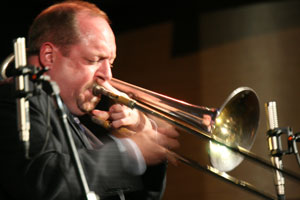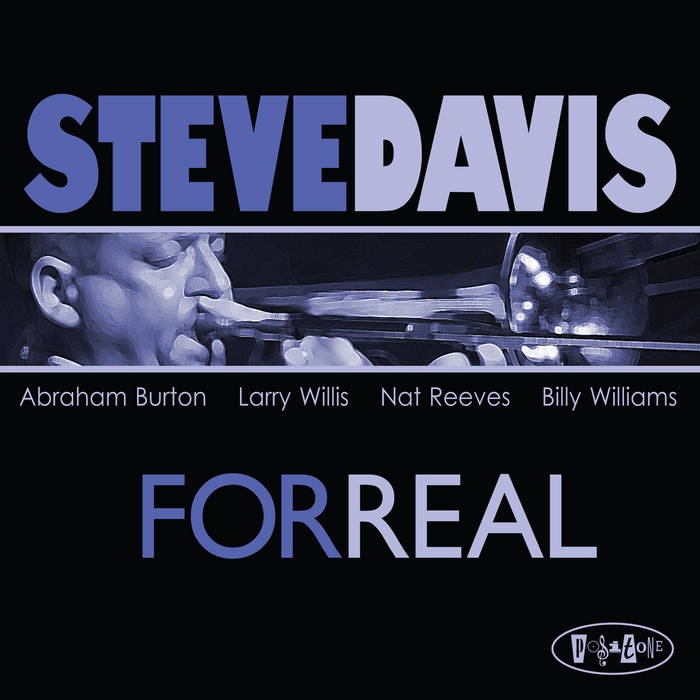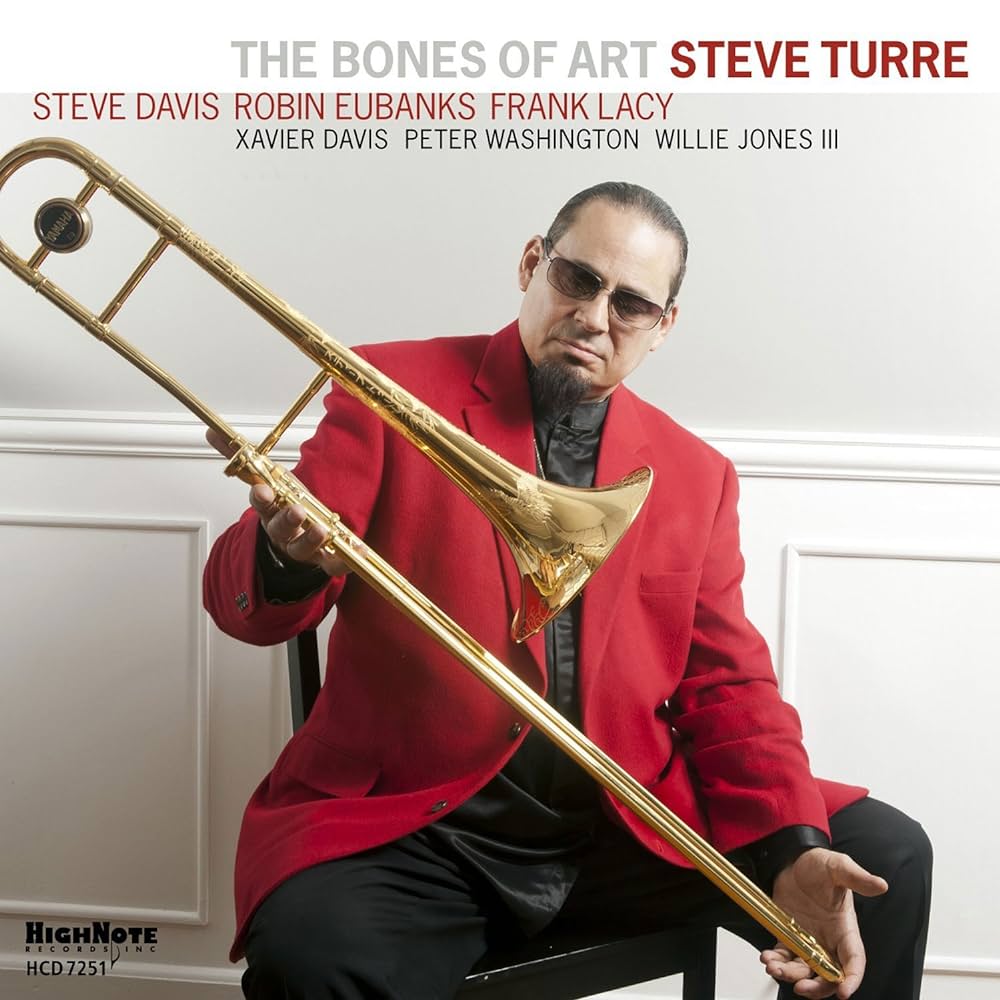Daylight – Steve Davis
An uptempo Latin song with a wide-open melody, Daylight is essentially a 32-measure blues. Steve Davis recorded three versions of this song: one quintet and two sextets. We have condensed scores and horn parts for all three arrangements.
- Recording: Steve Davis - For Real
- Recorded on: February 7, 2013
- Label: Posi-Tone (PR 8116)
- Concert Key: D
- Vocal Range: , to
- Style: Latin (uptempo)
- Trombone - Steve Davis
- Tenor Sax - Abraham Burton
- Piano - Larry Willis
- Bass - Nat Reeves
- Drums - Billy Williams
- Description
- Historical Notes
- Solos
- Piano Corner
- Bass Corner
- Drum Corner
- Guitar Corner
- Inside & Beyond
- Minus You
All three recordings of Daylight are slightly different; instead of lead sheets we have Concert Condensed Scores and horn parts for each arrangement. If you're playing this song in a setting with only one melody instrument, the first part works as a lead sheet for each version. Rhythm section players should read the Condensed Scores.
Daylight is a great song for starting to explore an uptempo Latin groove without too much rhythmic complexity. The melody is both simple—leaving plenty of space—and also concentrated in a narrow range of less than an octave. The changes are also relatively simple, though several different keys are visited toward the end of the form. This song is essentially a 32-measure blues in D, with 16 measures of "turnaround" after 16 measures for the I, IV, and back to the I. In the "turnaround" (C and D sections) the changes include modulations to E♭, D♭, and B major before descending further to A7. Our lead sheets show no key signature, partly due to these modulations and also the open-ended modal sound on the tonic chord. The last two phrases of the melody are complemented with rhythm section hits.
In all three recordings, there is a coda which vamps an eight-measure phrase featuring descending chords over a D pedal. The horns play these chords the first two times, followed by an open piano solo on the same vamp until the horns come in with the chords two more times, finishing with rhythm section hits setting up a final Dmaj7(♯11).
The original quintet recording begins with eight measures of bass setting up the groove, in a classic tumbao pattern (beat 1, the "and" of 2, and beat 4 tied over into the next measure). The piano and drums then enter for eight measures before the head; our score and parts show the top line of the two-measure piano pattern that repeats here. At C of the head, the rhythm section switches to a 1-feel (sometimes more of a 2-feel); D starts with a groove like A leading into the rhythm section hits. The solos keep the Latin groove throughout on this version, going straight into the out head after the last solo.
The melody phrasing is a little different on this quintet arrangement from the later sextet versions: the first and third measures of each phrase in A and B have a half note followed by a half rest, rather than whole notes. The two horns are harmonized throughout, mostly in thirds, with trombone on the melody and tenor sax on the lower harmony notes. The tenor has a half-note triplet countermelody in the second measure of D, which appears in the two sextet arrangements as well.
Daylight is a great song for starting to explore an uptempo Latin groove without too much rhythmic complexity. The melody is both simple—leaving plenty of space—and also concentrated in a narrow range of less than an octave. The changes are also relatively simple, though several different keys are visited toward the end of the form. This song is essentially a 32-measure blues in D, with 16 measures of "turnaround" after 16 measures for the I, IV, and back to the I. In the "turnaround" (C and D sections) the changes include modulations to E♭, D♭, and B major before descending further to A7. Our lead sheets show no key signature, partly due to these modulations and also the open-ended modal sound on the tonic chord. The last two phrases of the melody are complemented with rhythm section hits.
In all three recordings, there is a coda which vamps an eight-measure phrase featuring descending chords over a D pedal. The horns play these chords the first two times, followed by an open piano solo on the same vamp until the horns come in with the chords two more times, finishing with rhythm section hits setting up a final Dmaj7(♯11).
The original quintet recording begins with eight measures of bass setting up the groove, in a classic tumbao pattern (beat 1, the "and" of 2, and beat 4 tied over into the next measure). The piano and drums then enter for eight measures before the head; our score and parts show the top line of the two-measure piano pattern that repeats here. At C of the head, the rhythm section switches to a 1-feel (sometimes more of a 2-feel); D starts with a groove like A leading into the rhythm section hits. The solos keep the Latin groove throughout on this version, going straight into the out head after the last solo.
The melody phrasing is a little different on this quintet arrangement from the later sextet versions: the first and third measures of each phrase in A and B have a half note followed by a half rest, rather than whole notes. The two horns are harmonized throughout, mostly in thirds, with trombone on the melody and tenor sax on the lower harmony notes. The tenor has a half-note triplet countermelody in the second measure of D, which appears in the two sextet arrangements as well.
"For Real" is Steve Davis' fourth album as a leader for the Posi-Tone label. The same rhythm section played on his third Posi-Tone album, "Gettin' It Done" recorded in 2011. Steve and master pianist Larry Willis played together on quite a few recordings, including Larry's 2006 High Note album "Blue Fable."
Related Songs
Email Send Daylight to a friend
Send this page to a friend via email. Add your name or email in the first field. In the second, add one or more email addresses, separated by a comma.
- Recording: Steve Turre - The Bones Of Art
- Recorded on: March 18, 2013
- Label: HighNote (HCD 7251)
- Concert Key: D
- Vocal Range: , to
- Style: Latin (uptempo)
- Trombone, Shells - Steve Turre
- Trombone - Steve Davis, Frank Kuumba Lacy
- Piano - Xavier Davis
- Bass - Peter Washington
- Drums - Willie Jones III
- Percussion - Pedro Martinez
Video
- Description
- Historical Notes
- Solos
- Piano Corner
- Bass Corner
- Drum Corner
- Guitar Corner
- Inside & Beyond
- Minus You
A Condensed Score and first, second, and third trombone parts are available for this three-trombone sextet arrangement. The intro for this recording begins with the whole rhythm section vamping for 16 measures, again with a tumbao bass line. At C of the head there is no change of groove; the bass continues a variation of the tumbao pattern until the hits in the fourth measure of D. These hits also appear in the solo choruses in both sextet arrangements.
The three trombones are voiced mostly in triads; unlike the other sextet arrangement, the voicings include a 4-3 suspension (G to F♯, D7sus to D7) between the second and third measures of A. The half-note triplet countermelody in the second measure of D is harmonized in the second and third parts.
On this recording, Steve Turre (playing his trademark shells) and percussionist Pedro Martinez are the last two soloists; they play over an open D7 vamp. This is not shown in our score and parts; if you're playing this arrangement without a percussion soloist it certainly works to go back to the head right after the last chorus of the solo form.
The three trombones are voiced mostly in triads; unlike the other sextet arrangement, the voicings include a 4-3 suspension (G to F♯, D7sus to D7) between the second and third measures of A. The half-note triplet countermelody in the second measure of D is harmonized in the second and third parts.
On this recording, Steve Turre (playing his trademark shells) and percussionist Pedro Martinez are the last two soloists; they play over an open D7 vamp. This is not shown in our score and parts; if you're playing this arrangement without a percussion soloist it certainly works to go back to the head right after the last chorus of the solo form.
"The Bones Of Art" is the only Steve Turre album so far featuring Steve Davis. It's Turre's fourth album so far to feature a multi-trombone front line. Frank "Ku-umba" Lacy also played on two other Turre albums: "Rhythm Within" in 1995 and "Steve Turre" in 1996.
As one reviewer noted, "The fact that all the horn players at one time were part of Blakey's Jazz Messengers adds to a cohesiveness in ensemble playing and across solo playing that is a fine testament to Art's role as the world's greatest one-man jazz university."
As one reviewer noted, "The fact that all the horn players at one time were part of Blakey's Jazz Messengers adds to a cohesiveness in ensemble playing and across solo playing that is a fine testament to Art's role as the world's greatest one-man jazz university."
Related Songs
Email Send Daylight to a friend
Send this page to a friend via email. Add your name or email in the first field. In the second, add one or more email addresses, separated by a comma.
- Recording: One For All - The Third Decade
- Recorded on: October 20, 2015
- Label: Smoke Sessions (SSR 1605)
- Concert Key: D
- Vocal Range: , to
- Style: Latin (uptempo)
- Flugelhorn - Jim Rotondi
- Trombone - Steve Davis
- Tenor Sax - Eric Alexander
- Piano - David Hazeltine
- Bass - John Webber
- Drums - Joe Farnsworth
Video
- Description
- Historical Notes
- Solos
- Piano Corner
- Bass Corner
- Drum Corner
- Guitar Corner
- Inside & Beyond
- Minus You
A bit faster than the other two recordings, this sextet version has a similar intro to the original quintet version—eight measures of bass and eight adding piano and drums—though with a more active bass line. Again the groove changes to a 1-feel at C of the head; at D the energy picks up again with a samba bass line until the rhythm section hits. Some of the solos on this recording switch to a swing 4-feel. After the last solo, 16 measures of rhythm section vamp set up the out melody; the top line of the piano pattern is shown in our score and parts.
The horn voicings are similar to the Steve Turre recording, but not identical. In the second time through the coda, the trombone 3rd part adds another half-note triplet countermelody in the second measure; this coda has 16 measures written out in the score and 3rd parts but eight measures in the 1st and 2nd parts (indicated "twice") as they play the same eight measures twice each time.
The horn voicings are similar to the Steve Turre recording, but not identical. In the second time through the coda, the trombone 3rd part adds another half-note triplet countermelody in the second measure; this coda has 16 measures written out in the score and 3rd parts but eight measures in the 1st and 2nd parts (indicated "twice") as they play the same eight measures twice each time.
One For All first got together in 1996,recording their first album "Too Soon To Tell" the following year at the Van Gelder Recording Studio. The 2016 release of "The Third Decade" marked 20 years of this sextet's existence. Their first album for the Smoke Sessions label, it also includes a version of Jim Rotondi's Ruth, which Jim originally recorded in a quartet setting with the same rhythm section.
Related Songs
Email Send Daylight to a friend
Send this page to a friend via email. Add your name or email in the first field. In the second, add one or more email addresses, separated by a comma.

Steve Davis
born on April 14, 1967
Steve Davis is widely regarded as one of today's leading improvisers on the trombone. His lyrical, hard-swinging style first gained him broad recognition during the 1990s while working with the bands of jazz legends Art Blakey, Jackie McLean, Chick Corea's Origin and the cooperative sextet, One For All. Steve also followed in his mentor Curtis Fuller's footsteps by joining saxophone legend Benny Golson and The New Jazztet in 2008. Read more...
There was a problem.
...





